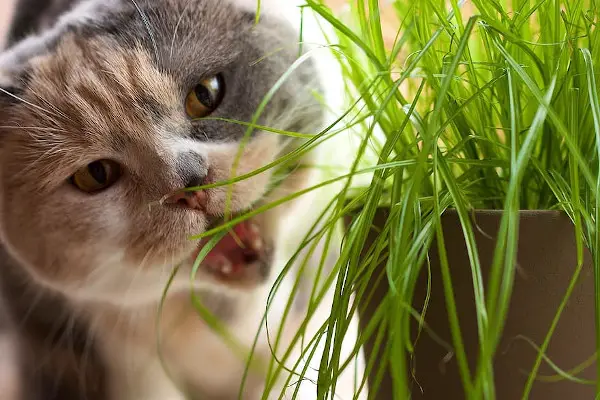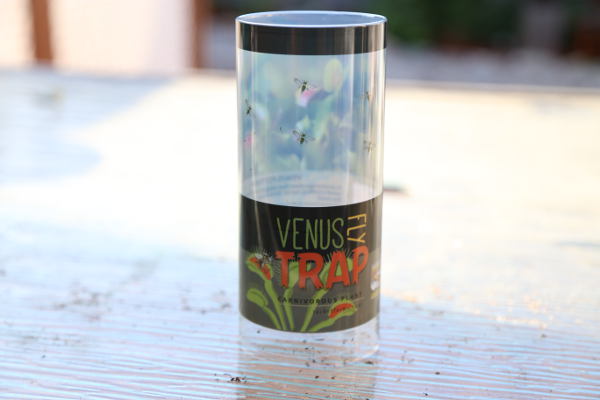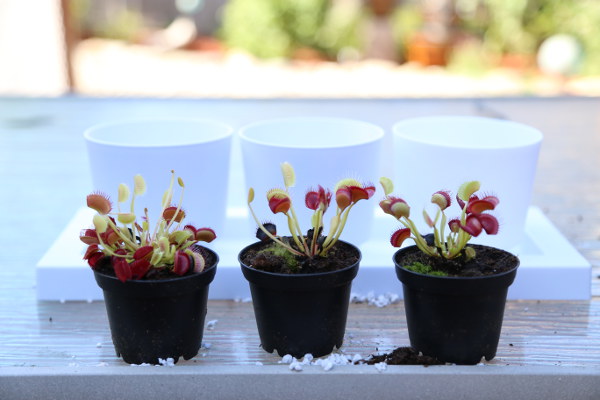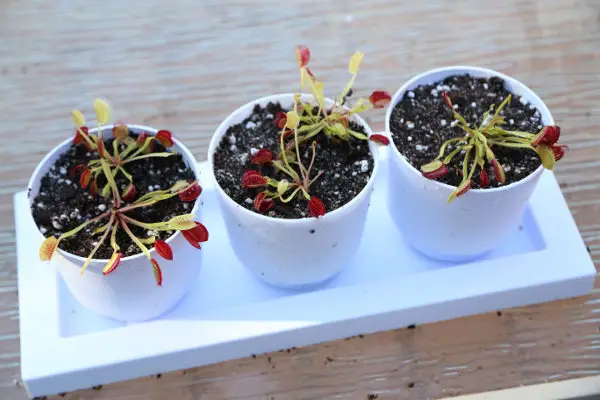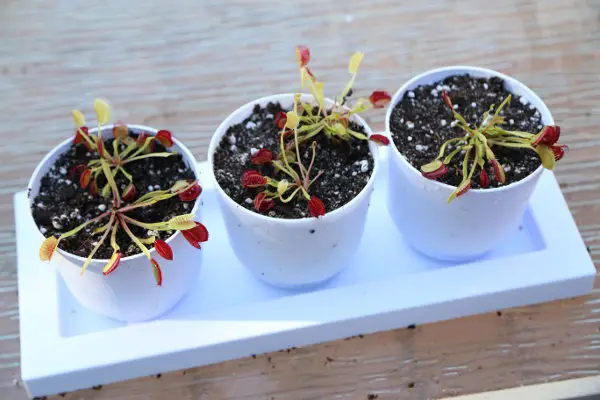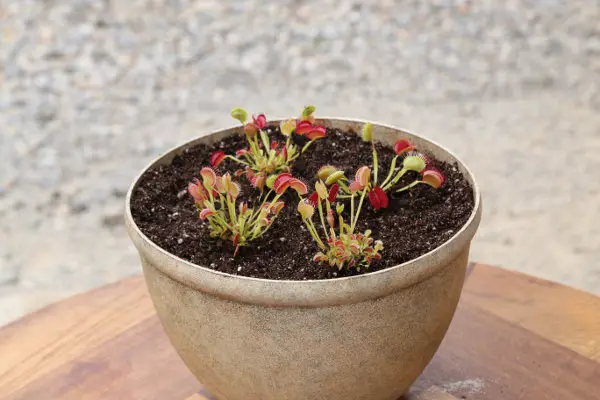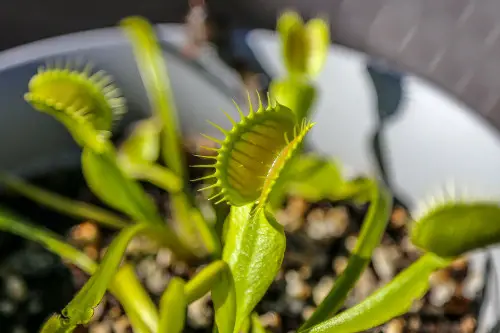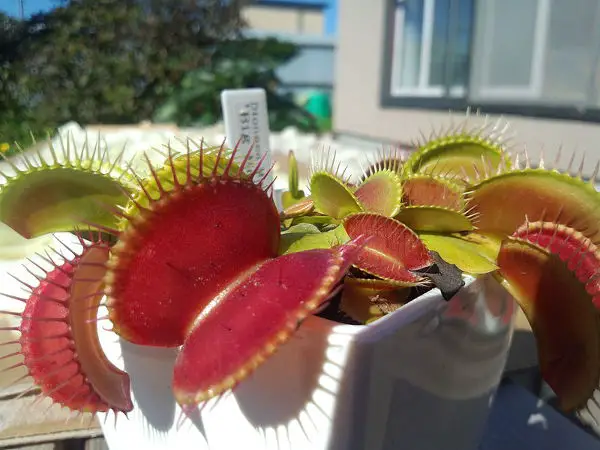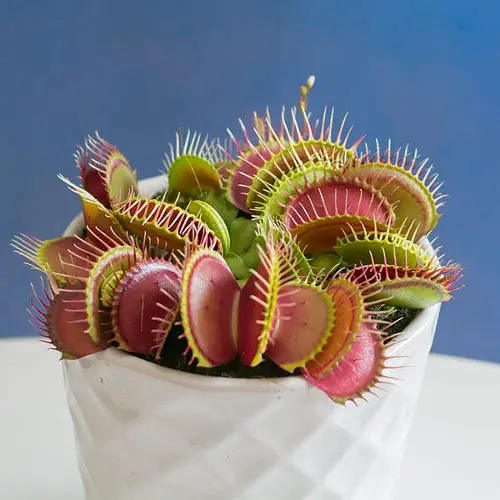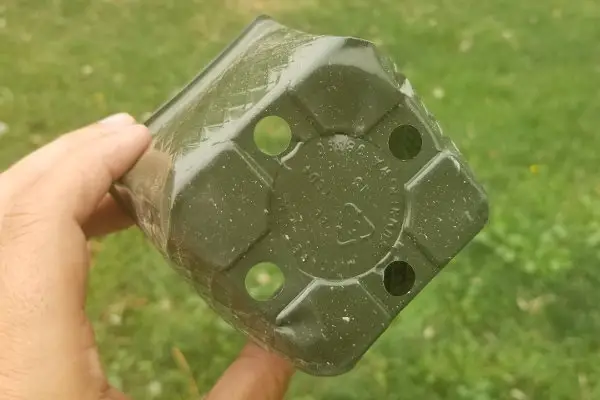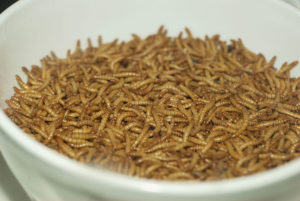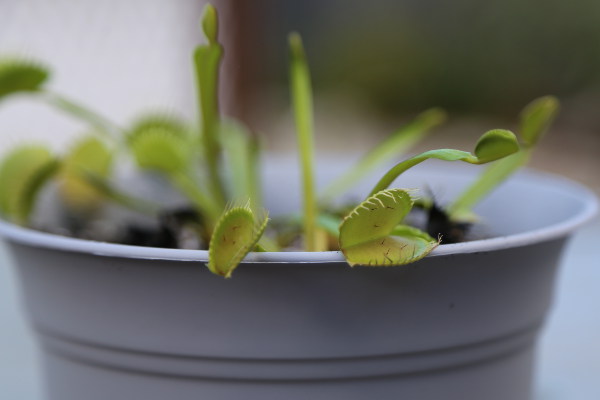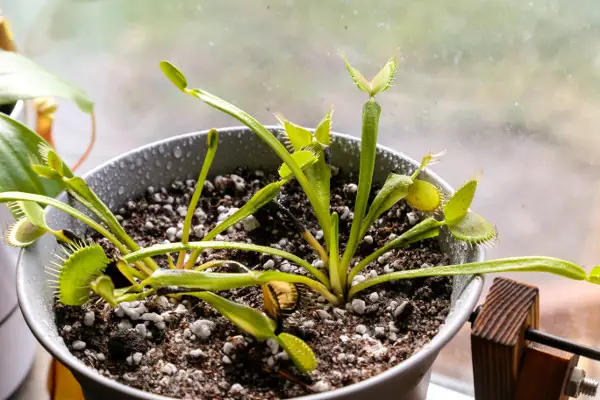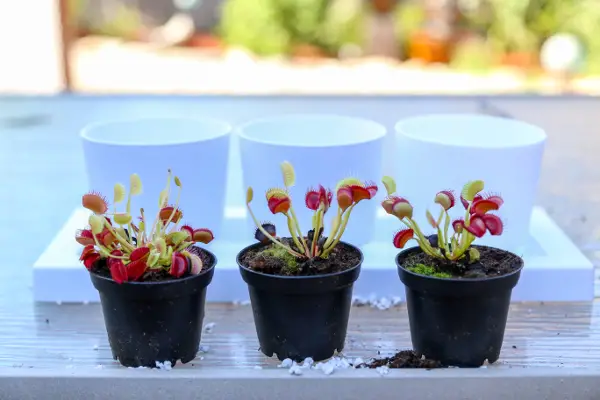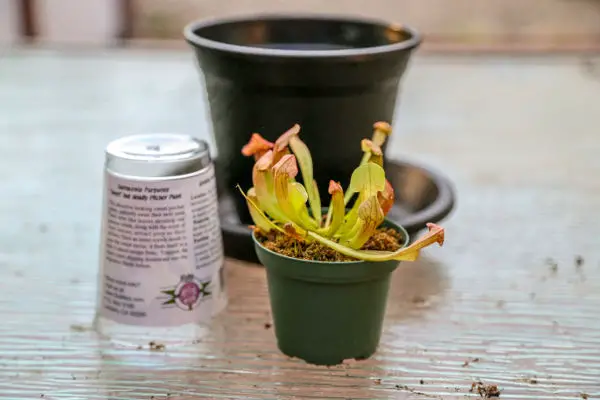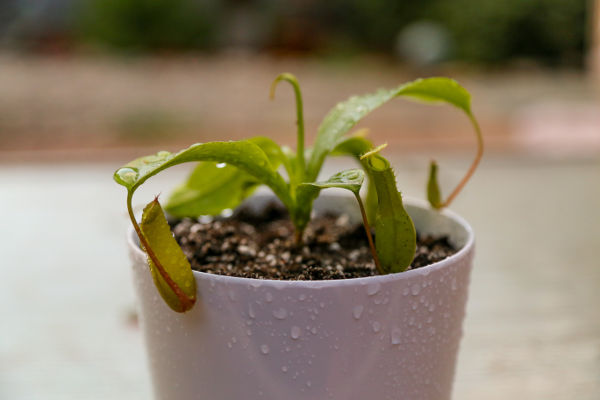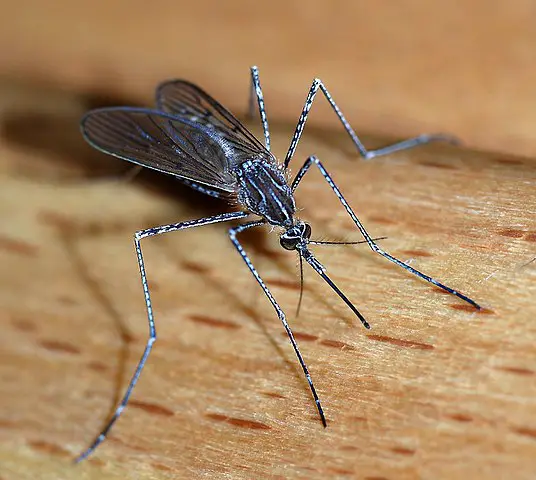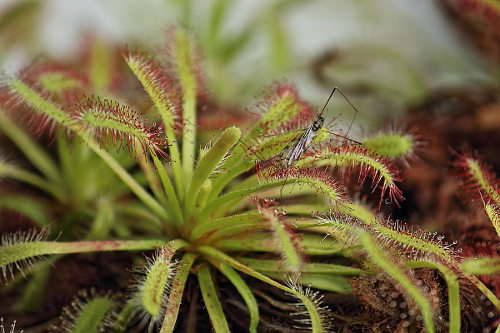I’ve been so excited to bring you this nepenthes ventrata care guide. I have recently got back into collecting and growing carnivorous plants and my nepenthes ventrata is just taking off! I bought this little nepenthes from a death cube at Lowes. I also recently purchased a couple of more mature nepenthes ventrata from Home Depot.
It’s not the way I planned on getting back into caring for carnivorous plants but when I saw it, I just couldn’t help myself! I did some searching online and found a little bit of info, but no one really expanded on how to care for a nepenthes ventrata. I know a lot of people are out there look for a nepenthes ventrata care guide after buying on from either Home Depot or Lowes.
Today we will be talking about caring for these beautiful tropical pitcher plants. We will also talk about identifying them and where you can get them. More than likely you are her because you purchased one at Home Depot or Lowes and you are trying to learn how to care for or identify.
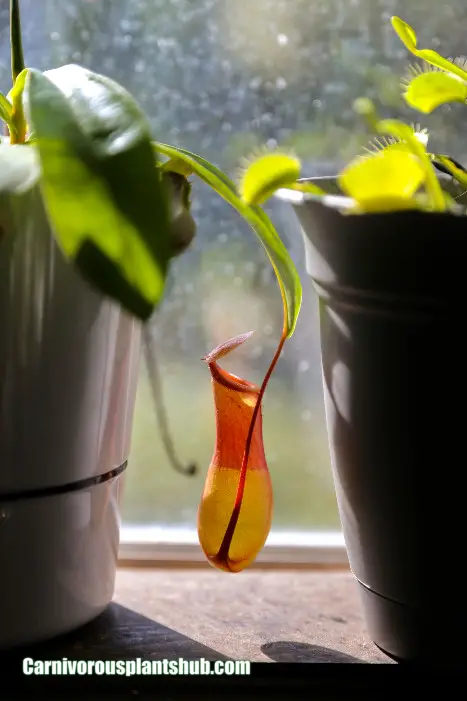
A beautiful new pitcher on my nepenthes ventrata. Sitting next to my Venus Flytraps!
I’m a part of many Facebook groups where people purchase a nepenthes ventrata and have no idea what it is. It’s one of the most commonly grown nepenthes for mass production. Mostly because they are very hardy and simple to grow, as long as you know what your doing!
The care they need is much different than almost any other houseplant. They are a carnivorous plant and need special attention. Once you understand what they need, they are pretty simple and fun to grow!
If you are looking for a specific section of this ultimate nepenthes ventrata care guide, use the table of contents below to jump to a different area.
Don’t forget to subscribe to my YouTube channel to the right. You can see nepenthes ventrata care and updates on my personal plants. Subscribe so you can get updates. Also, don’t forget to share this care guide on your favorite social media platform, just click below!
Buy Carnivorous Plants Online!
Buy carnivorous plants from the most reputable and trusted carnivorous plant nursery, California Carnivores. We have partnered up and are giving all my viewers an exclusive 10% discount on your entire carnivorous plant order! Just enter CPHUB at checkout! Get the coolest venus flytrap cultivars, sarracenia, nepenthes and much MUCH more! You can even buy your next bag of premium carnivorous plant soil from them!
Order Plant Mail, Click Here!
Pinterest
Facebook
Twitter
Reddit
Table of Contents
Ultimate Nepenthes x Ventrata Care Guide
These tropical pitcher plants are truly amazing. They are one of the few truly tropical plants you can grow in your home to give it a true tropical feel. The giant pitchers hanging from the plant makes it look like something straight out of the jungle. Even though these originate from a jungle you can actually grow them with minimal humidity!
They are extremely tolerant and most people can grow them in just about any climate indoors. As long as you have a window that will give them a little light and sun during the day, they should thrive. Lets get started!
About Nepenthes x Ventrata
Before we dig too deep into the care for these tropical pitcher plants, lets take a moment to learn a little about them. Feel free to skip this section if you just want the care guide. I think it’s important to know a little bit about the plant you are caring for!
The nepenthes x ventrata is a hybrid cultivar that comes from two different tropical nepenthes plants. The nepenthes ventricosa and the nepenthes alata. See where it got its name? This is a naturally occurring hybrid that originates in the Phillipines.
This plant was introduced to the world in 1979 via the Carnivorous Plan Newsletter. Even though this plant originates from the Philippines, it’s one of the most commonly grown nepenthes plant in the US. It’s likely that there are more of these around the world now than in the Philippines.
The traps will typically be 4-6 inches big. The traps will usually consist of two colors, a yellowish green and a pinkish red. The traps start off as the yellowish green at the bottom then slowly fade to the pinkish red. They don’t have the biggest pitchers but what they lack in size they will makeup for in quantity. Mature plants can maintain a dozen healthy pitchers or more at a time!
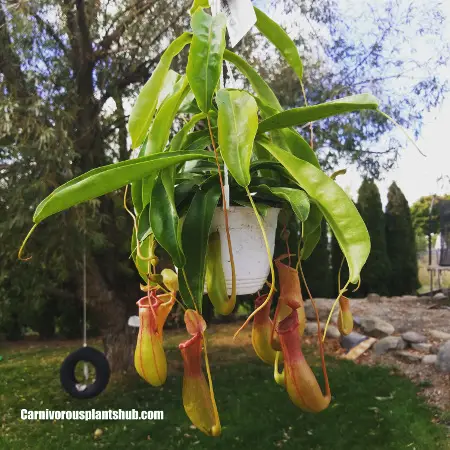
My more mature nepenthes ventrata I purchased from Home Depot. It had two plants that I repotted and separated!
One of the main reasons for it’s popularity is how easy they are to grow. They are a very tolerant plant and can be grown in areas that do not have a lot of humidity. This is a special characteristic for a tropical plant.
One of the reasons the nepenthes ventrata is so tolerant is the N. Ventricosa is a highland species and the N. Ventrata is a lowland species. The Ventrata is a mix of these two. It can tolerate a wider spectrum of humidity and temperatures due to it coming from both environments.
How To Identify A Nepenthes x Ventrata Pitcher Plan
They are actually pretty easy to identify. One of the easiest ways to do so is to simply take a look at some photos online. It may be a little harder to identify if it doesn’t have any pitchers. The color of the pitchers makes it pretty clear if your plant is a nepenthes ventrata or not.
Take a look at the photo of the pitcher below. You can see it’s two tone, this one almost looks like it was painted two different colors. They will either look like this or the greenish yellow will blend into the red a little more. Sometimes the pitchers will have green/yellow and red mixed all over the pitcher.
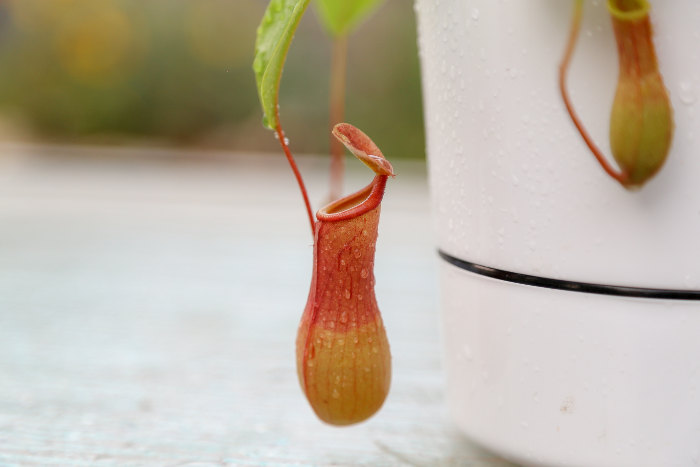
Copyright carnivorousplantshub.com
Either way, one of the easiest ways to identify a nepenthes ventrata is by the color of the pitchers. I can identify these now the moment I see one since they have such a distinct color of pitchers.
The leaves of a nepenthes ventrata will be a very lush deep green. Nepenthes can be difficult to identify just by the leaves but know that a nepenthes ventrata’s leaves (if healthy) will typically only be green. If you see any red or other colors in the leaves, it might be a different kind of nepenthes. Check out the photo below that has a pitcher and a leaf!
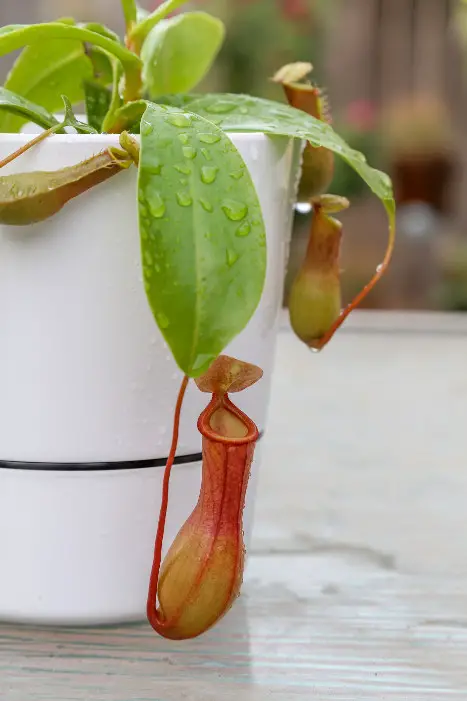
Copyright: carnivorousplantshub.com
Nepenthes x Ventrata Soil Or Substrate
There are two main or most popular options when looking at nepenthes ventrata soil or substrate needs. I’ve actually used both and both have worked great. I would say it comes down to your personal preference and what’s easier. Or maybe your decision is based on the aesthetic of the media. Check out both options below.
Long Fiber Spagnum Moss
If you ask the question in any community for carnivorous plants or nepenthes, the most popular will always be LFSM or long fiber sphagnum moss. I really like growing my plants in long fiber sphagnum moss. It’s extremely absorbent and you almost have to try to let this stuff dry out. Long fiber sphagnum moss can actually carry 18 times its weight in water.
It also adds a cool aesthetic to your nepenthes ventrata. The photo below is actually not a ventrata but you can see what the aesthetic looks like on one of my other nepenthes. Some people really don’t like the way long fiber sphagnum moss looks though, so it’s really your preference.
You simply just soak the LFSM in distilled water. It will soak up a ton of water, probably more than you expect. Then you simply wrap your roots up with the long fiber spagnum moss. Check out the video below of me replanting a few of my nepenthes and sundews in long fiber sphagnum moss. These are not nepenthes ventrata but you give your ventrata regardless of size, the exact same treatment!
You can actually purchase some long fiber sphagnum moss from Amazon below! This is a great source and I have used their LFSM before. It’s high quality and will serve you well! Just remember to also pick up some distilled water to soak it!
Last update on 2024-05-12 / Affiliate links / Images from Amazon Product Advertising API
https://youtu.be/-zX8U_ndEhA
Peat Moss, Perlite & Sillica Sand Mix
This is also an extremely popular carnivorous plant mix or soil. This is the one I use primarily, for my venus flytraps and my nepenthes ventrata. Mostly because I have a surplus of it as I make it myself. At the bottom of this sections I’ll share a video of me actually making the mix.
I usually try to go 2 parts peat moss, 2 parts perlite and 1 part silica sand. I honestly don’t use exact measurements anymore but it’s really close to that. I like buying all three of these ingredients and making the soil myself.
This is a great mix that is well aeriated. You always want a very well draining soil mix that can also absorb and slowly distribute the water. The peat moss and perlite both do a great job absorbing but also allowing excess water to move on to the bottom. Nepenthes ventrata are very susceptible to root rot and need good drainage. This mix will do just that.
Check out the premade mix below. I have seen many people use this organic mix, and everyone I’ve talked to have been really happy with it!
Last update on 2024-05-12 / Affiliate links / Images from Amazon Product Advertising API
If you are interested in making your own carnivorous plant soil mix for your nepenthes ventrata, check out the video I made below showing you exactly how!
https://youtu.be/q6WaSVn3bKg
Watering Your Nepenthes x Ventrata
One of the most important things to remember when it comes to nepenthes ventrata care is is to only use distilled, rain water or water obtained through reverse osmosis. Carnivorous plants need water that is pure and doesn’t have any minerals. These minerals can burn the roots. This is the number one way people kill their plant.
Most people just treat them like normal house plants not understanding that they need distilled water to take care of them. You can buy distilled water from most big box stores for under a dollar a gallon. Just keep stalked up on it and it shouldn’t be too much of a hassle.
If you don’t want to be running to the store to get distilled water, you can collect rain water. There are systems to collect rain water from your gutters that are pretty easy to set up. The other option is to use a reverse osmosis system in your kitchen. These can be a little pricey, but are worth the money. I’ll go over both options below.
Collecting Rain Water
There are systems you can set up to collect rain water right off your gutter. They are incredible simple to set up. I strongly recommend first getting a TDS meter so you can make sure your rainwater coming off your roof doesn’t have any contaminants in it. Sometimes materials used for roofing can leach chemicals and make the water poisonous to your plants.
Check out the TDS meter below, it’s an easy solution to seeing if your gutter water will work for your nepenthes ventrata. As long as it’s under 50 PPM, you should be fine! It’s also just nice to have one of these meters to measure your personal drinking water, you never know exactly what is in it.
Last update on 2024-05-12 / Affiliate links / Images from Amazon Product Advertising API
Once you know your the rain water coming off your gutter is pure enough, then you can install a rainwater collection system. All you do is cut off a section of your gutter and connect this piece below.
Last update on 2024-05-12 / Affiliate links / Images from Amazon Product Advertising API
After you connect that, you run a tube from the spout to a collection barrel. The barrel houses your rain water and waits for you to come and use it! Some of the barrels, like the one below, even have water spouts so you can easily collect your rain water.
Last update on 2024-05-12 / Affiliate links / Images from Amazon Product Advertising API
There is a little bit of a startup cost for getting your rain water system set up but your garden will thank you. Especially with all the restrictions on water recently, this might be a good idea. Whether you have a nepenthes ventrata to water or not!
Reverse Osmosis Water System
Another option for getting pure water without going to the store would be a reverse osmosis water system. I’m not familiar enough with these to know what magic happens on the inside, but they will filter your water to a pure state. Don’t confuse these with normal water filtration, it’s completely different.
Normal water filters do not have the ability to filter out all the minerals in water like a reverse osmosis system does. They have counter top systems you can get, which are easier to set up or you can opt for an under the counter system.
The under the counter system hooks up to your sink and all your tap water is now pure with reverse osmosis, check out the two different systems below.
Below is the countertop version.
Last update on 2024-05-12 / Affiliate links / Images from Amazon Product Advertising API
Or you can go with the under the counter version to make all your tap water pure. Not only will this improve your drinking water but you will have unlimited water for all your carnivorous plants right from the tap!
Last update on 2024-05-12 / Affiliate links / Images from Amazon Product Advertising API
Tropical Pitcher Plant Watering Instructions
Nepenthes ventrata are a tropical plant and although they are extremely tolerant they do like a little bit of humidity. If you live in an area that is naturally humid, they will likely be just fine. If you live in a place (like me) that has almost no humidity, you might need to help out just a bit.
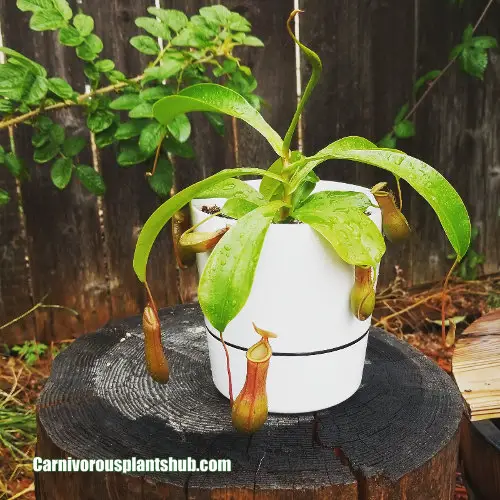
Here is my young nepenthes ventrata I sat out in the rain to get some natural light and rainwater. It’s mostly inside but I will set it in the rain from time to time if it’s not too cold!
Misting the pitchers and the leaves once a day can help create a more humid climate for your plant. Make sure you never let your nepenthes x ventrata sit in a water tray. They are susceptible to root rot. However, if you get some fish tank rocks put them in a tray add some distilled water and place your plant on top of the rocks, some of that humidity will rise without your plant sitting in water.
Keep the substrate of your nepenthes ventrata moist at all times. Never let your plant dry out but also don’t drown the plant in water. It should always be wet to the touch but water should never puddle and the substrate should never be soupy.
I like to mist the main stem of my plant and let the water fall to the roots. That way I’m misting and watering the plant at the same time. You will want to get a good mister to help you mist the plant. It can be a little tricky if you do not have one of these, check out one I really like on Amazon below.
Its also a good idea to make sure there is a little distilled water in the pitchers. Filling them 1/4th of the way is plenty. They will create a natural nectar and shouldn’t need to be constantly filled. You usually only need to add distilled water when they are very young or if you just brought one home from a nursery or store. Often times the pitchers are dried up and can use a little help.
Best Pot Or Planter For Your Tropical Pitcher Plant
I have found that while your nepenthes ventrata is young, you can get away with planting it in normal planters. There are a couple rules to follow for these carnivorous plants however. As they get older and the pitchers get bigger, you will likely need to repot them into a hanging planter.
Make sure that the planter you select is a resin or plastic. If you want ceramic, make sure it’s fully glazed. Ceramic planters can leach minerals into the soil and hurt your plants roots.
I have found that the resin and plastic hanging planters work the best. The quicker you get your nepenthes ventrata in a hanging planter the better they will grow the way they want and acclimate.
Make sure the planter you get has holes in the bottom for good drainage. This is really important as these plants are susceptible to root rot. Good drainage is extremely important with your substrate and your planter. If the water is unable to drain, your plant will have a hard time surviving.
Check out my recommendations for planters below.
Nepenthes Ventrata Lighting & Food Needs
Most people think that since they are carnivorous plants that you have to feed them. Honestly, this really isn’t true. They obtain most of their energy through photosynthesis and need a fair amount of sun. Insects act more like a fertilizer for the plants but not always 100% needed.
If you make sure your plant gets 8-12 hours of indirect sunlight a day via a window, it will likely be enough. Most houses have a few house flies and fruit flies flying around, your ventrata will likely catch them. In most cases you really don’t need to feed your plant any insects.
You can feed them fish food or small insects like ants if they seem like they need something extra. If you can’t get pitchers to grow, its more likely that they aren’t getting enough sun or water. But, feeding them some fish food or an insect on occasion certainly doesn’t hurt.
Please do not put this plant in a dark corner of your house. If it’s not getting some indirect sun it will not live. The best places for them is in a window in a kitchen or bathroom. The kitchen or bathroom tend to naturally be the more humid rooms in the home. They can give the plant a little natural humidity.
If you put your plant in an area that gets enough indirect sun the odds are its also catching its fair share of bugs. Feeding these plants is not really needed unless you can tell with 100% certainty they are not getting any insects, ever.
Artificial Lighting
If you really want to put your nepenthes ventrata in a corner of your room that gets no natural lighting, you will need to purchase some artificial lighting. I personally use a 36W Sansi bulb that plugs into a standard E26 socket.
We decided to do just this for a couple of nepenthes ventrata we have in the corner of our dining room. We just purchased a clamp shop light and the Sansi bulb and clamped it to our curtain rod and pointed it at our plants. This should provide plenty of light for your nepenthes ventrata. Check out our set up below.
Try to keep your lights around 15 inches or so away from your plants. On our setup below, we rotate which plant goes on top to ensure they both get adequate light. It’s a little trickier with two plants vs just 1 plant.
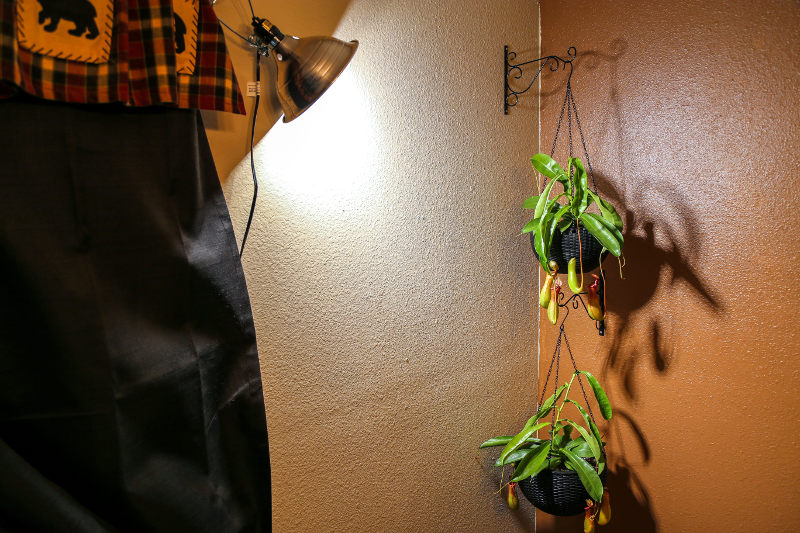
Our setup in our dining room. This light is only on overnight, we do not turn it on during the day.
Keep in mind, we only have this light on during the night time. We mostly hide the clamp light when its day time. They do have some really nice fixtures you can get to put in a living room that would look beautiful! I’ll show you what we use for our setup below plus I’ll show you some really nice fixtures that would look great in a living room!
Last update on 2024-05-12 / Affiliate links / Images from Amazon Product Advertising API
Last update on 2024-05-12 / Affiliate links / Images from Amazon Product Advertising API
Check out some of the more attractive fixture options below for a nice aesthetic look in your living space. All the options below plug into a standard 12V wall outlet making them easy to just plug in.
Last update on 2024-05-12 / Affiliate links / Images from Amazon Product Advertising API
Nepenthes Ventrata Temperature & Humidy
The nepenthes ventrata is very tolerant when it comes to both temperature and humidity. It’s able to survive and adapt to a wide variety of both temperatures and humidity levels. Keep in mind however, it is a tropical pitcher plant. This means it is used to at least some humidity.
Temperature
Make sure you try to keep it above 50 degrees and be sensible with high temperatures. Anything over 100 degrees I’d try to keep it out of the direct sun. The have been known to tolerate temperatures even below 50 degrees but I think at that point your gambling and could lose your ventrata.
The great thing about these plants is they thrive around room temperature. It’s one of the reasons they are a great indoor plant. If you keep your temperatures normal and your plant inside, temperature shouldn’t be a problem!
Humidity
In the most ideal situation, humidity should be around 70% or higher. They do like a lot of humidity but can live in much less. Right now, I have a hard time getting my humidity levels above 50% without any kind of encasement. My ventratas do fine even in that low of a humidity level.
If you live in an area with very little humidity you can keep the plant misted to to help. I mist mine twice a day, once in the AM and later on before bed. You can also put some fish tank rocks in a tray and fill it with distilled water. Set your plan on top of the tray (assuming it’s not hanging) and it will soak up some of that humidity.
You can also use a small humidifier close to your plant.
Something like the humidifier above can help keep the humidity up for your nepenthes x ventrata. I have had ventratas that grow really well without the extra humidity but the pitchers will grow larger and stay around longer with better humidity. Just remember, if you can’t meet the higher humidity, your plant should still do really well.
Nepenthes Ventrata Q & A
I wanted to take some time to answer some super common questions I see when people first buy their plant and reach out for nepenthes ventrata care tips. I’m in several different groups on social media and see people bringing these home from Lowes, Home Depot, Wal-Mart and other local nurserys and box stores.
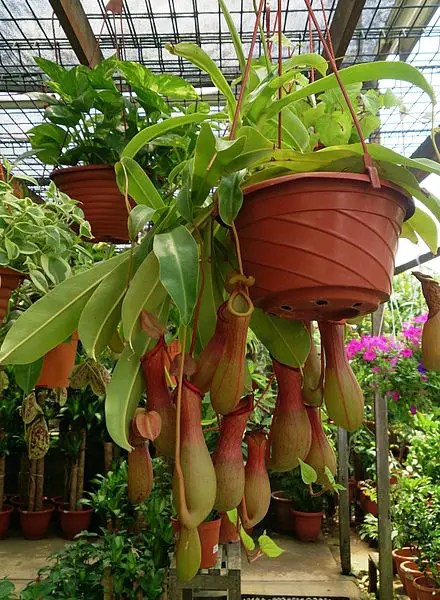
A beautiful full grown nepenthes ventrata.
Often times, people have no idea how to grow a carnivorous plant so they reach out to these groups for help. Which is awesome! I’m really glad they are doing that instead of just killing the plant and moving on. Check out some of the common questions below.
Do Nepenthes Ventrata Pitcher Plants Need Direct Sun?
Having direct sun for part of the day will be beneficial to the nepenthes ventrata. It’s not 100% necessary though. Your ventrata can do really well with 8-10 hours of indirect sun coming from a window. It is easy to give them too much sun, so if you do leave them in direct sun try not to do more than 6-8 hours a day. Be sensible with super high temperatures, bring them in if it goes above 100 for long periods of time.
How Long Do Nepenthes Pitcher Plants Last?
They should last a long time as they can live domestically and in the wild for 10-20 years.
How Often Should I Water My Nepenthes Ventrata?
Make sure to keep your tropical pitcher plant moist but not soggy or water logged. It’s hard to predict how often you will need to water as your temperatures and humidity will dictate this. Make sure they never dry out and always keep the media moist.
You can also mist your plants twice a day if you find that your area has low humidity, anything under 60%. When misting the plant, it’s important to mist the main stem and some of the leaves but not necessary to waterlog the substrate.
Should I Fill The Ptichers With Water?
You should never fill the pitchers completely with water. If your pitchers already have liquid in the bottom there is really no need to add more water. If you have found they are completely dry, you can help them out by adding a little water to the pitcher. Try not to go over 1/4th of the size of the pitcher.
It’s pretty common to see them be completely dried out when you bring them home from the big box stores. Just add a little bit of distilled water to help the plant start to produce it’s own sweet nectar to attract insects.
Why Isn’t My Nepenthes Ventrata Growing Pitchers?
There are two very common reasons why your pitcher plant isn’t growing pitchers. The biggest reason is not enough sun or light. They do need a fair amount of light to induce photosynthesis to create pitchers. Often times, just giving them more sun can start the process of growing the pitchers. If you insist having them in a non sunlit area, you will need grow lights. They will not produce pitchers in low light conditions.
The second likely reason is they are not getting enough water or humidity. We already talked about how to water and keep them humid above. Check that out. If you aren’t growing pitchers, make sure your plant isn’t drying out and try to help create a little more humidity.
Are Venrata Pitcher Plants Toxic To Cats Or Dogs?
There is absolutely no scientific evidence to support that they are toxic in anyway. Like most house plants, if your animal ingests them, they may be in for an upset stomach but it isn’t toxic. When I did research on this topic, I couldn’t find one reported incident of a nepenthes pitcher plant harming any pets.
Why Are My Pitchers Turning Brown & Dying
Don’t panic! This is super common. Even the most healthy nepenthes ventrata pitcher plant will lose its pitchers. It’s also super common for many of the pitchers to die off during the acclimation period.
They need some time to acclimate to their new area and may lose a few pitchers along the way. Don’t panic though, if you are taking care of your nepenthes ventrata according to this care guide, your plant will recover and grow beautiful new pitchers.
In some more uncommon cases your plant may get a disease or fungal infection. If this is the case, you will need to do research on your specific case to see what you can do to help it. Posting in nepenthes communities can be a great way to share your photos and get good expert advice on your plants disease!
Should I Trim Off Dead Pitchers?
Yes, its definitely a good idea to trim off all the dead and dried up pitchers. Once they turn completely brown and shrivel up, you can cut it off right at the tip of the leaf it’s growing from. Do not cut the leaves off. Just because the pitcher died that the leaf produced doesn’t mean that leaf isn’t still beneficial to the plant.
Even though it’s pitcher died that leaf is still soaking up sun to help the plan with photosynthesis.
My Personal Nepenthes Ventrata Plants
I wanted to direct you to a couple of links and videos where you can watch me caring for my own personal nepenthes ventrata plants. Check out my plants below, I keep this page updated with my nepenthes I purchased from Lowes as a baby.
You can also check out a couple of my videos below highlighting my young nepenthes ventrata and my more mature plant I rescued from Home Depot. If you enjoy these videos be sure to subscribe to my channel so you can keep getting the updates! Just hover over my photo on the video below in the upper left, then hit subscribe.
https://youtu.be/yqOHVnnIiBAhttps://youtu.be/khaEES7OT6E
Other Great Content From CarnivorousPlantsHub.com
Final Thoughts
Thank you so much for coming here to learn about these wonderful plants. I hope this ultimate nepenthes ventrata care guide will help you learn how to take care of this plant.
These amazing tropical pitcher plants will bring you joy for many, many years when taken care of properly. They give your home that incredible fresh tropical feel. If you really liked this guide and found it helpful, please share with your friends or on your favorite social media platform. Don’t forget to subscribe to our YouTube channel fore more great content!
If you are interested in carnivorous plant conservation, please head on over to the International Carnivorous Plant Society to see how you can help!
